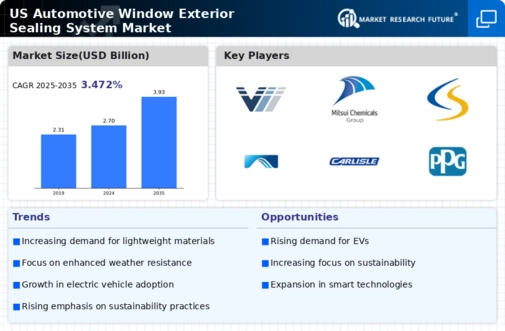Stringent Regulatory Standards
The automotive window-exterior-sealing-system market is significantly influenced by stringent regulatory standards imposed by US authorities. These regulations focus on enhancing vehicle safety, environmental sustainability, and energy efficiency. For instance, the National Highway Traffic Safety Administration (NHTSA) has established guidelines that mandate specific performance criteria for sealing systems, particularly concerning water and air leakage. Compliance with these regulations is essential for manufacturers, as non-compliance can lead to substantial penalties and reputational damage. Consequently, the automotive industry is compelled to invest in advanced sealing technologies that not only meet but exceed these regulatory requirements. This trend is expected to drive innovation within the automotive window-exterior-sealing-system market, as companies seek to develop solutions that align with evolving standards while also improving overall vehicle performance.
Rising Vehicle Production Rates
The automotive window-exterior-sealing-system market experiences growth driven by increasing vehicle production rates in the US. In recent years, the automotive industry has seen a resurgence, with production levels reaching approximately 10 million units annually. This surge in vehicle manufacturing necessitates the incorporation of effective sealing systems to enhance vehicle performance and durability. As manufacturers strive to meet consumer demand for new vehicles, the need for high-quality sealing solutions becomes paramount. The automotive window-exterior-sealing-system market is likely to benefit from this trend, as automakers prioritize the integration of advanced sealing technologies to ensure optimal performance and compliance with regulatory standards. Furthermore, the anticipated growth in electric vehicle production may further bolster demand for innovative sealing solutions, as these vehicles often require specialized sealing systems to accommodate unique design features.
Consumer Demand for Enhanced Comfort
Consumer preferences are shifting towards vehicles that offer enhanced comfort and convenience, which directly impacts the automotive window-exterior-sealing-system market. As buyers increasingly prioritize features such as noise reduction, climate control, and overall ride quality, the demand for effective sealing solutions becomes more pronounced. High-quality sealing systems play a crucial role in minimizing external noise and preventing air leaks, thereby contributing to a more comfortable driving experience. Market data indicates that vehicles equipped with superior sealing technologies can achieve up to a 30% reduction in cabin noise levels. This growing consumer expectation for comfort and luxury is likely to drive manufacturers to invest in advanced sealing solutions, thereby propelling the automotive window-exterior-sealing-system market forward.
Growth of Electric and Hybrid Vehicles
The automotive window-exterior-sealing-system market is poised for growth due to the increasing popularity of electric and hybrid vehicles in the US. As consumers become more environmentally conscious, the demand for electric vehicles (EVs) and hybrids is on the rise, with sales projected to reach 25% of total vehicle sales by 2030. These vehicles often require specialized sealing solutions to accommodate unique design features, such as battery compartments and aerodynamic structures. Consequently, manufacturers are focusing on developing sealing systems that cater specifically to the needs of EVs and hybrids, which may include lightweight materials and enhanced thermal insulation properties. This shift in consumer preference towards greener alternatives is likely to create new opportunities within the automotive window-exterior-sealing-system market, as companies adapt their product offerings to meet the evolving demands of the automotive landscape.
Technological Innovations in Sealing Solutions
Technological advancements in sealing solutions are a key driver of growth in the automotive window-exterior-sealing-system market. Innovations such as the development of multi-material seals and the integration of smart technologies are enhancing the performance and functionality of sealing systems. For example, the introduction of thermoplastic elastomers (TPE) has improved the durability and flexibility of seals, making them more effective in various environmental conditions. Additionally, the incorporation of sensors and smart materials into sealing systems is gaining traction, as these technologies can provide real-time feedback on seal performance. This trend towards innovation not only enhances the reliability of sealing solutions but also aligns with the automotive industry's broader push towards modernization and efficiency. As a result, the automotive window-exterior-sealing-system market is poised for significant growth driven by these technological advancements.























Leave a Comment